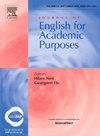Writing a successful applied linguistics conference abstract: The relationship between stylistic and linguistic features and raters’ evaluations
IF 3.4
1区 文学
Q1 EDUCATION & EDUCATIONAL RESEARCH
引用次数: 0
Abstract
The conference abstract (CA) is a promotional genre that is vital to academic success. However, composing a high-quality abstract can be challenging for both first (L1) and second language (L2) writers. Some researchers have performed contrastive analyses of accepted/rejected CAs, yet few studies have analyzed the extent to which different stylistic and linguistic features can predict reviewers' scores. The current study furthers this line of inquiry, while also responding to scholars' recent calls for more replication work in the fields of applied linguistics and second language acquisition. Using a corpus of 304 abstracts from an applied linguistics conference, the current study is an approximate replication that analyzes the extent to which 32 variables are predictive of CA raters’ evaluations. Data analyses consisted of multiple stages, including examining the relationships between CA scores and nine stylistic variables (e.g., rhetorical moves, study completeness) and 23 linguistic variables (e.g., grammatical errors, and lexical and syntactic complexity measures). Statistically significant variables were then entered into a regression model. Results suggest that seven variables accounted for approximately 25 percent of CA scores. The pedagogical implications of these findings are discussed for L1/L2 writers, along with future research directions.
成功撰写应用语言学会议摘要:文体和语言特点与评分者评价之间的关系
会议摘要(CA)是一种对学术成功至关重要的宣传体裁。然而,撰写高质量的摘要对第一语言(L1)和第二语言(L2)写作者来说都是一项挑战。一些研究人员对被接受/被拒绝的论文摘要进行了对比分析,但很少有研究分析不同的文体和语言特点能在多大程度上预测审稿人的评分。目前的研究进一步推进了这一研究方向,同时也响应了学者们最近提出的在应用语言学和第二语言习得领域开展更多复制工作的呼吁。本研究使用了一个应用语言学会议的 304 篇摘要语料库,近似复制分析了 32 个变量在多大程度上可以预测 CA 评委的评价。数据分析包括多个阶段,其中包括研究 CA 评分与 9 个文体变量(如修辞动作、研究完整性)和 23 个语言变量(如语法错误、词法和句法复杂性测量)之间的关系。然后将具有统计学意义的变量输入回归模型。结果表明,七个变量约占 CA 分数的 25%。本文讨论了这些发现对 L1/L2 级写作者的教学意义以及未来的研究方向。
本文章由计算机程序翻译,如有差异,请以英文原文为准。
求助全文
约1分钟内获得全文
求助全文
来源期刊

Journal of English for Academic Purposes
Multiple-
CiteScore
6.60
自引率
13.30%
发文量
81
审稿时长
57 days
期刊介绍:
The Journal of English for Academic Purposes provides a forum for the dissemination of information and views which enables practitioners of and researchers in EAP to keep current with developments in their field and to contribute to its continued updating. JEAP publishes articles, book reviews, conference reports, and academic exchanges in the linguistic, sociolinguistic and psycholinguistic description of English as it occurs in the contexts of academic study and scholarly exchange itself.
 求助内容:
求助内容: 应助结果提醒方式:
应助结果提醒方式:


